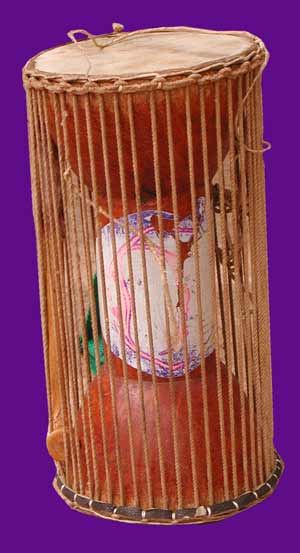| 
N'tama
(en langue bamanan) ou dumanun
en langue bomu
Connu aussi sous le nom de Tamani
Bois, peau
L : 42,7 cm, D : 14,3 cm
Le n'tama
est un petit tambour à deux peaux tendues par des cordelettes sur un
corps cylindrique en bois largement entaillé en son milieu et qu'on
appelle communément "tambour à aisselles".
On le trouve
chez les Malinké, Khassonké, Minianka et notamment les Bwa.
Deux types d'instruments sont presque omniprésents dans la production
musicale de ces derniers. Le tambour à aisselle qu'ils appellent dumanu
(en langue bomu), et un autre petit tambour à deux membranes, appelé
i'izo, moins long que le premier et dont
le corps cylindrique en bois n'est pas entaillé.
Ces deux instruments, généralement joués ensemble, entrent dans la composition
d'autres ensembles instrumentaux, tels que les balafon
(xylophones appelés cooza chez les Bwa)
dont la forme arquée les rapproche des xylophones d'Afrique centrale
et les différencie du xylophone bamanan, les grands tambours et les
corps.
Source
: Musée
National du Mali |
| The
N'tama (Armpit drum)
N'tama
(in the Bamanan language) dumanun (in the
Bomu language) or Tamani
Wood, skin
Length: 42,7 cm Diam: 14,3 cm
The n'tama,
commonly known as an "armpit drum", is a small drum with two
skins stretched, with short strings, over a cylindrical wooden frame
with a wide gash around the middle.
It is found
amongst the Malinké, Khassonké, Minianka and most particularly the Bwa.
Two kinds of instrument are almost universally present in the musical
performances of this latter people: the armpit drum which they call
dumanu (in the Bomu language), and another
small two-skinned drum called an i'izo,
not as long as the first and whose cylindrical wooden frame is not gashed.
These two instruments, generally played together, are part of the make-up
of other groups of instruments such as balafon
(xylophones which the Bwa call cooza) whose
curved shape resembles that of the xylophones of Central Africa. This
shape distinguishes them from the Bamanan xylophone, the large drums
and the frames.
Source
: National
Museum of Mali
|
